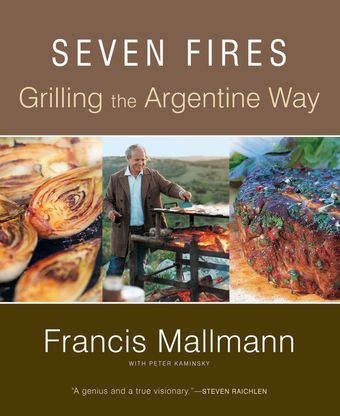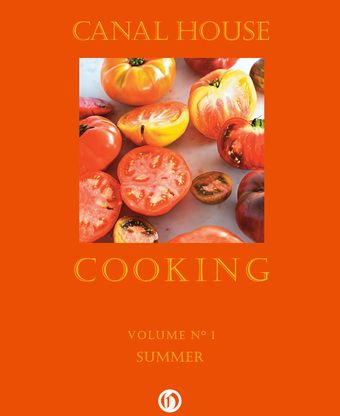Judging between Seven Fires and Canal House Cooking was no easy task. I fell in love with both books, which convey a romantic, even idyllic passion for cooking and entertaining. They give the reader a window into the philosophy and lifestyle of the authors and they present appealing recipes in a straightforward way.
Seven Fires tells the story of Francis Mallmann, one of the most celebrated chefs in South America who, after decades of training under culinary masters, cooking for kings and dignitaries, realizes the most satisfying and honest food he can produce is the casual, rustic cuisine of his homeland, Argentina. Inspired by a lifetime of “campfires and cattle drives,” fueled by a penchant for open flames and cast iron, Mallmann develops a style of cooking based around seven forms for harnessing fire, from grill to griddle, wood oven to embers. The resulting book provided me with a heightened understanding of the integral role heat plays in the cooking process. But more than that, it spurred a desire to follow this great man over the plains of the Patagonia, lighting fires and roasting meat on a spit wherever we may roam.
In a similar vein, Canal House Cooking, written in an equally personal tone, describes how authors Melissa Hamilton and Christopher Hirsheimer abandoned the world of New York food magazines (they both worked at Saveur) to open a workshop and cooking studio on the banks of a canal, in what they call a small American river town. Here they collaborate on culinary projects, design and illustrate cookbooks, test recipes and, above all, cook. This book is the first in a series they plan to publish a few times a year. I received the summer volume in late August, allowing me to cook from it using the freshest seasonal ingredients I could find. The design drew me in immediately. The book is small and is bound in a soft cover with a bright orange jacket and minimal outside script. Inside, the chapters are divided in a playful manner with titles such as Working up an Appetite and Too Many Tomatoes. I thought the attention to detail in font and layout was beautiful, making the recipes and notes easy to follow. The softly lit, matte food photos are interspersed with lovely illustrations by Hamilton. The voice in the recipes is friendly and informal.
I tried three recipes from Canal House Cooking, all of which were successful and delicious. The first, Grilled Shrimp with Anchovy Butter, was staggeringly simple and its powerful flavors lingered in my memory for days. The anchovy butter was nothing short of miraculous; the lemon wedges lent a needed brightness to cut the fat. My guests and I mopped up the excess sauce with anything we could find, eating much of the shrimp shells, too, so as not to waste a drop. This will no doubt become part of my kitchen repertoire.
I then made the Soft Zucchini with Harissa, Olives and Feta as well as the Plum Tart. I loved that each recipe taught me to use an ingredient in a new way: harissa, it turns out, is the best addition to salad dressing I have found in a decade; chopped anchovies melted in butter with lemon makes the perfect no-fuss seafood sauce; plums placed cut-side up in a tart are far easier to manage than placed cut-side down; and heavy cream is a great alternative to egg-wash for brushing on puff pastry edges.
That said, it occurred to me after all this cooking that the dishes felt more like ideas or inspirations than recipes somehow, perhaps because they felt so intuitive, so simple to make. Canal House Cooking can also sometimes seem limited in scope. As a series, used together with the upcoming volumes, the project promises to be more substantial, but as a book on its own, it was somehow not as weighty as I would have liked. Although I understand from their introduction that the book is a modest collection of delicious recipes they like to cook for family and friends at this time of year, there didn't seem to be a connection between some of the dishes they included. Certain chapters, like "Two Steaks Feed Four," contained just two or three recipes, which together formed one complete dish without much variation. A few were oddly dated or impractical for the average home cook, like employing gelatin to make a gelée, or the six pages dedicated to making a paella for 20 people on an outdoor grill.
I cooked from Seven Fires simultaneously and where at moments I could not find an appropriate recipe for my occasion or mood from Canal House Cooking, I could not stop finding dishes to make from this book. I cooked seven recipes from Seven Fires. Dinner one night was Mallmann’s well-charred Churrasco steak with Chimichurri, accompanied by Humita, a savory corn pudding with chili and basil. Both were rewarding to make and outstanding to eat. The preparation of the Humita was a bit of an ordeal as it calls for the corn to be grated raw off the cob. My husband took on this task with great abandon, splashing corn juice all over the kitchen walls, to be found in unlikely places days later. A close friend, observing the mess in action, asked if it made any sense to tamper with perfect corn at the peak of its season -- why go to the trouble when it's so delectable boiled and eaten as is? But one taste of the finished dish and we were silenced. Although the pudding did not thicken to the consistency we'd imagined, its sweet, buttery flavor and herbal undertones were worth every bit of trouble.
The Chicken Chimehuin, a whole chicken slathered in garlic, fresh herbs and lemon, cut open through its breast and grilled, was amazingly moist and pleasing. So too were the Burnt Tomatoes and Fennel with Mustard Vinaigrette. Throughout the book, Mallmann emphasizes the importance of what he calls the taste of "burnt," noting that a moderate charring or burning of food “wakes up the palate and surprises you” and can be extremely seductive with its slight bitterness and dark crust. Given this permission to char my food more than I usually would was revelatory. I felt a great sense of liberation as I allowed my halved tomatoes to develop a smoky black layer in the cast-iron skillet. The outcome was not only beautiful but enhanced the ripe tomato flavor considerably. In some small way, Mallmann enabled me to bring the open fires of the Argentine gauchos to my cramped New York apartment.
My crowning achievement, however, was Mallmann’s Dulce de Leche Panqueque, thin eggy crepes, filled with sweet, caramelized condensed milk. It has been many years since I have gone to the effort of making crepes from scratch (not since it was my job to do so every morning as a line cook at Le Cirque 2000 over a decade ago) -- not because crepes are so difficult, but because they are one of those foods I would rather someone else make for me, at a street cart in Belgium or France. But the photos of these sweet little parcels were so appealing that I could not resist! The batter was straightforward; the outcome was not only intensely satisfying but impressed my dinner guests to no end. They seriously believed the beauty of each crepe had to do with my dexterity as a cook. Only I knew it was the foolproof recipe that allowed me to flip and roll eight flawlessly browned discs.
In the end it was Seven Fires that I kept coming back to. Not only did I learn a great deal about this style of cooking, but I felt a sincere sense of familiarity with the author and his fierce passion for the foods of Argentina. I loved that Mallmann gives a realistic indoor and outdoor option for every dish and a thorough explanation of its significance. And his voice, conveyed by American food writer Peter Kaminsky (who has also co-authored books with Daniel Boulud and Gray Kunz), is commanding and dramatic, imparting a sense of romance that I doubt could be pulled off by an American. Mallmann skillfully captures the vast expanse of his country’s cuisine and leaves me wanting more.



6 Comments
Thank you, Gail. Of the other reviews of this book, none cited this feature. In fact, the reviewers didn't seem to be aware of it. I've had this book for a while (as I've had Canal House), but I've never done more than read it. Now I'm going to cook from it. Brava, Gail! ;)
Viva food52!
Christopher & Melissa